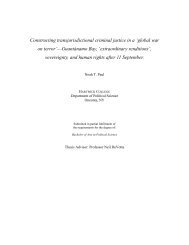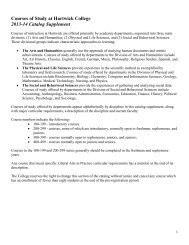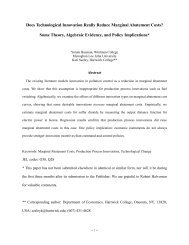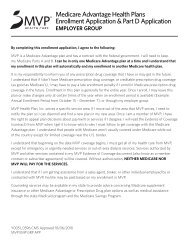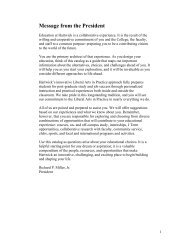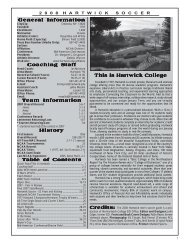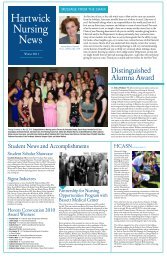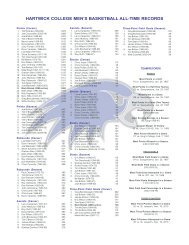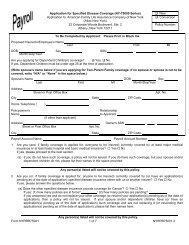Table of Contents - Hartwick College
Table of Contents - Hartwick College
Table of Contents - Hartwick College
You also want an ePaper? Increase the reach of your titles
YUMPU automatically turns print PDFs into web optimized ePapers that Google loves.
Kingdom with a focus on their reproductive biology. Groups include<br />
cyanobacteria, fungi, algae, mosses, ferns, gymnosperms, and flowering<br />
plants. The structures and characteristics <strong>of</strong> flowering plants will be<br />
examined in detail, emphasizing the characteristics <strong>of</strong> the major families.<br />
Laboratories will involve microscopic and macroscopic analysis <strong>of</strong><br />
members <strong>of</strong> the groups discussed in lecture. Prerequisites: Biol 104, 105.<br />
(LAB)<br />
310 Neurobiology (A) (4 credits; 3 one-hour lectures and 1 three-hour<br />
laboratory weekly) An introduction to cellular and integrative<br />
neurobiology, this course <strong>of</strong>fers a comprehensive overview <strong>of</strong> the<br />
anatomy, chemistry, physiology, and biophysics <strong>of</strong> the nervous system.<br />
The course begins with the study <strong>of</strong> neurons and associated cells and<br />
progresses to the examination <strong>of</strong> the ways these cells are organized into<br />
functional circuits that process information and mediate behavior. Topics<br />
include neuroanatomy, electrical properties <strong>of</strong> nerve cells, neurochemistry<br />
and synaptic mechanisms, neural systems, motor and sensory systems,<br />
learning, memory, behavior, and developmental neurobiology.<br />
Prerequisites: Biol 104, 105. (LAB)<br />
315 Microbial Ecology (4 credits; 3 one-hour lectures and 1 three-hour<br />
laboratory weekly) The biotic and abiotic factors that determine the<br />
distribution and abundance <strong>of</strong> microorganisms in natural systems will be<br />
discussed in this course. Topics will include physiological limitations <strong>of</strong><br />
growth, interspecific interactions amongst microorganisms and<br />
interactions <strong>of</strong> microorganisms with animals and plants as well as<br />
microbial contributions to biogeochemical cycles and usage <strong>of</strong><br />
microorganisms for environmental and biotechnology purposes. The<br />
laboratory emphasizes methods for studying microorganisms from, or in,<br />
environmental systems. Prerequisites: Biol 215 or Biol 303 or permission<br />
<strong>of</strong> the instructor. (LAB)<br />
321 Electron Microscopy (4 credits; 3 one-hour lectures and 1 fourhour<br />
laboratory weekly) The theory and practice <strong>of</strong> the preparation and<br />
examination <strong>of</strong> biological specimens by light microscopy, transmission<br />
and scanning electron microscopy, x-ray microanalysis and image<br />
analysis. Lecture will emphasize the theory behind specimen preparation,<br />
instrumentation, and interpretation <strong>of</strong> subcellular ultrastructure. In the<br />
laboratory, students will prepare specimens that they will examine and<br />
photograph with the electron microscopes. Prerequisites: Biol 104, 105, or<br />
permission <strong>of</strong> the instructor. (LAB)<br />
325 Forest Ecology (P) (4 credits; 6 hours <strong>of</strong> combined<br />
lecture/laboratory weekly) An upper division course for majors designed<br />
to follow the general ecology course. The lecture portion <strong>of</strong> the course<br />
examines the historical, ecological and biogeographic factors that have<br />
contributed to the determination <strong>of</strong> “community structure” in forests<br />
primarily from the northeast U.S. The laboratory entails a detailed<br />
analysis <strong>of</strong> a section <strong>of</strong> forest at Pine Lake. Prerequisites: Biol 303. (LAB)<br />
392 Junior Research (2 credits) Research methods preparing students<br />
for the Senior Project. Meets once a week. Must be taken before Biol 490.<br />
420 Developmental Genetics (4 credits; 3 one-hour lectures weekly;<br />
seminar format) Advanced study <strong>of</strong> current research on the molecular and<br />
cellular mechanisms that control growth, development and regeneration<br />
in organisms. Topics include the control <strong>of</strong> gene expression, cell-cell<br />
64



